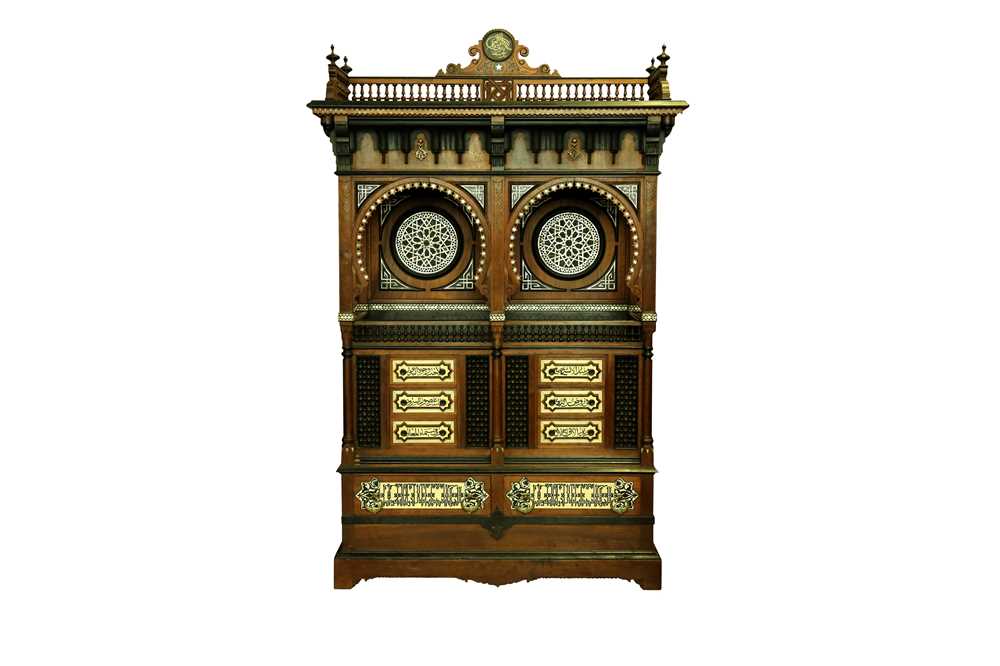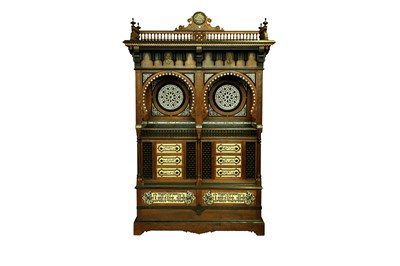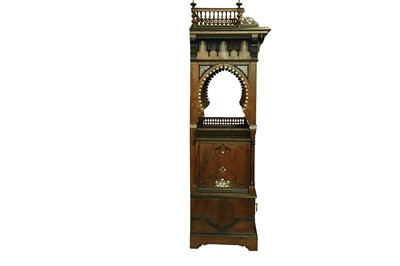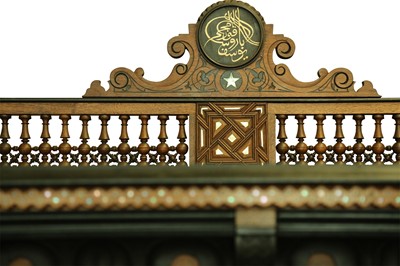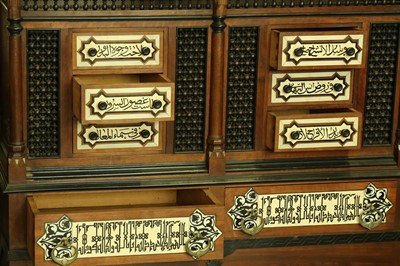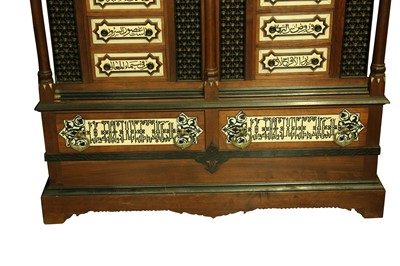2nd Dec, 2020 14:00
A Middle Eastern Journey | Live Online
λ A HARDWOOD BONE, RESIN AND MOTHER-OF-PEARL-INLAID ORIENTALIST CABINET BY GIUSEPPE PARVIS
Italy or Egypt, second half 19th century
λ A HARDWOOD BONE, RESIN AND MOTHER-OF-PEARL-INLAID ORIENTALIST CABINET BY GIUSEPPE PARVIS
Italy or Egypt, second half 19th century
Of typical rectangular shape, resting on four bracket feet, divided in three levels, the bottom with two large rectangular drawers inlaid with bone, ebonised wood and celluloid panels with pseudo-calligraphic bands in floriated Kufic script, flanked by vegetal arabesques, the centre with two Hispano-Moresque revival horse-shoe arches overlooking the top of the chest of drawers, outlined with a mashrabiya-style openwork balustrade, with six smaller drawers inlaid with bone, ebonised wood and celluloid with thuluth calligraphic cartouches, mother-of-pearl-inlaid geometric and star-shaped decorations to the back, the top with two further drawers decorated with ebonised wood applied decorations imitating Islamic architectural spandrels and muqarnas ceilings, a balustrade at the top surmounted by a roundel with the name of the maker (Giuseppe Parvis - Yusef Parvis) in the tughra style, 178.5cm x 115cm x 53.5cm.
Giuseppe Parvis (1831-1909) was an Italian carpenter, cabinetmaker and furniture designer, particularly acclaimed and praised for his "Parvis style", a subtle and aesthetically-pleasing fusion of Arab-inspired geometries and designs blended with the long-standing Italian carpentry tradition and refined furniture making skills. He was born in a humble home in a rural area called Lomellina, in the Italian region of Piedmont, in 1831. Completed his studies at the Accademia Albertina in Turin, he moved to Paris to practice as sculptor and engraver. Growing impatient of the lack of his success and in need of a change, in 1859 he left Paris and moved to Cairo, Egypt, where he quickly built a reputation for himself as cabinetmaker, getting noticed and appreciated by the local governor Isma'il. His long-aimed international fame finally concretised with the Gold Medal won at the Universal Expositions in Paris in 1867, with his exotic design of the Egyptian pavilions, followed by further praises at the Expositions of Philadelphia in 1876, Milan in 1881 and Turin in 1884.
Giuseppe Parvis can be considered a true icon of the 19th century: a self-made man of humble origins; eager to learn and achieve the success he believed he deserved; inventive and sensitive to the social changes undergoing in the West; and not at all immune to the lure of the East, similarly to several artists across all 19th-century Europe.
For further reference on 19th-century Parvis style furniture, please see Enrico Colle, Il Mobile dell'Ottocento in Italia: Arredi e Decorazioni d'Interni dal 1815 al 1900, 2007, pp. 138 - 143.
This item may require Export or CITES licences in order to leave the UK or the European Union. It is the buyer's responsibility to ensure that lots have the relevant licences before shipping.
Sold for £3,500
Includes Buyer's Premium
Do you have an item similar to the item above? If so please click the link below to submit a free online valuation request through our website.
